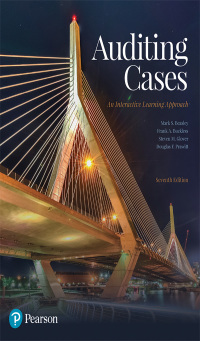Assume you are the partner in an accounting firm hired to perform the audit on a fortune
Question:
The client is currently undergoing a three (3) year income tax examination by the Internal Revenue Service (IRS). A significant issue involved in the IRS audit encompasses inventory write-downs on the tax returns that are not included in the financial statements. Because of the concealment of the transaction, the IRS is labeling the treatment of the write-down as fraud.
The company has a share-based compensation plan for top-level executives consisting of stock options. The value of the options exercised during the year was not expensed or disclosed in the financial statements.
The company has several operating and capital leases in place, and the CFO is considering leasing a substantial portion of the assets for future use. The current leases in place are arranged using special purpose entities (SPEs) and operating leases.
The company seeks to acquire a global partner, which will require IFRS reporting.
The company received correspondence from the Securities and Exchange Commission (SEC) requesting additional supplemental information regarding the financial statements submitted with the IPO.
Write an eight to ten (8-10) page paper in which you:
Evaluate any damaging financial and ethical repercussions of failure to include the inventory write-downs in the financial statements. Prepare a recommendation to the CFO, evaluating the negative impact of a civil fraud penalty on the corporation as a result of the IRS audit. In the recommendation, include essential internal control procedures to prevent fraudulent financial reporting from occurring, as well as the major obligation of the CEO and CFO to ensure compliance.
Examine the negative results on stakeholders and the financial statements of an IRS audit which generates additional tax and penalties or subsequent audits. Assume that the subsequent audit and / or additional tax and penalties result from the taxpayer's use of an inventory reserve account, applying a 10 percent reduction to inventory over three (3) years.
Discuss the applicable federal tax laws, regulations, rulings, and court cases related to the inventory write-downs, and explain the specific relevance of each to the write-down.
Research the current generally accepted accounting principles (GAAP) regarding stock option accounting. Evaluate the current treatment of the company's share-based compensation plan based on GAAP reporting. Contrast the financial benefits and risks of the share-based compensation stock option plan with the financial benefits and risks of a share-based stock-appreciation rights plan (SARS). Recommend to the CFO which plan the company should use, and provide the correct accounting treatment for each.
Research the reporting requirements for lease reporting under GAAP and International Financial Reporting Standards (IFRS). Based on your research, create a proposal for future lease transactions to the CFO. Within the proposal, discuss the use of off-the-balance sheet financing arrangements, capital leases, and operating leases, and indicate the related business and financial risks of each.
Create an argument for or against a single set of international accounting standards related to lease accounting based on the global market and cross border leases of assets. Examine the benefits and risks of your chosen position.
Examine the major implications of SAS 99 based on the factors you discovered during the initial evaluation of the company. Provide support for your rationale.
Analyze the potential for a material misstatement in the financial statements based on the issues identified in your initial evaluation. Make a recommendation to the CFO for the issuance of restated financial statement restatement. Identify at least three (3) significant issues that can result from the failure to issue restated financial statements.
Examine the economic effect of restatement of the financial statements on investors, employees, customers, and creditors.
Use five (5) quality academic resources in this assignment. Note: Wikipedia and other Websites do not qualify as academic resources.
Your assignment must follow these formatting requirements:
Be typed, double spaced, using Times New Roman font (size 12), with one-inch margins on all sides; citations and references must follow APA or school-specific format. Check with your professor for any additional instructions.
Include a cover page containing the title of the assignment, the student's name, the professor's name, the course title, and the date. The cover page and the reference page are not included in the required assignment page length.
The specific course learning outcomes associated with this assignment are:
Analyze accounting situations to apply the proper accounting rules and make recommendations to ensure compliance with generally accepted accounting principles.
Analyze business situations to determine the appropriateness of decision making in terms of professional standards and ethics
Analyze business situations and apply advanced federal taxation concepts.
Use technology and information resources to research issues in accounting.
Write clearly and concisely about accounting using proper writing mechanics.
Financial Statements
Financial statements are the standardized formats to present the financial information related to a business or an organization for its users. Financial statements contain the historical information as well as current period’s financial... Stakeholders
A person, group or organization that has interest or concern in an organization. Stakeholders can affect or be affected by the organization's actions, objectives and policies. Some examples of key stakeholders are creditors, directors, employees,... GAAP
Generally Accepted Accounting Principles (GAAP) is the accounting standard adopted by the U.S. Securities and Exchange Commission (SEC). While the SEC previously stated that it intends to move from U.S. GAAP to the International Financial Reporting Standards (IFRS), the... Corporation
A Corporation is a legal form of business that is separate from its owner. In other words, a corporation is a business or organization formed by a group of people, and its right and liabilities separate from those of the individuals involved. It may...
Fantastic news! We've Found the answer you've been seeking!
Step by Step Answer:
Related Book For 

Auditing Cases An Interactive Learning Approach
ISBN: 9780134421827
7th Edition
Authors: Mark S Beasley, Frank A. Buckless, Steven M. Glover, Douglas F Prawitt
Question Posted:





